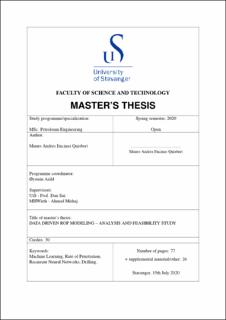| dc.description.abstract | Increasing the drilling speed in wells while maintaining the operational safety standards is a challenge that many Petroleum Engineers have undertaken. In recent years, high complexity wells (Horizontal, Extended Reach, HPHT, etc.) have been drilled increasingly, this forced the industry to continue investigating which parameters involved in the Rate Of Penetration (ROP) have the most influence on its behavior. This study integrates different concepts and methodologies from Petroleum Engineering, Drill String Mechanics, Data Analysis, and Machine Learning (ML). It aims to identify the most important parameters involved in ROP, using real well data to evaluate the influence of these parameters in different ML ROP predictive models.
The methodology includes the study of different physics-based ROP models, even though some of them were developed decades ago but remain relevant to this date. Improvement of these models accuracy came with the implementation of new technology and equipment on the drill site, such as Wired Drill Pipe, Precise Sensors, Top Drive Technology, Measurement While Drilling, Logging While Drilling, and many more. Those developments generated large quantities of data that companies used to store and now are proven to be relevant to understand and explain phenoms involved in drilling a well.
During the study, one parameter consistently appeared to be on top of all others Weight on Bit (WOB). All physics-based models projections are based on the accuracy of it, but in high complexity wells as the ones drilled nowadays, it is not easy to estimate, as Surface WOB (SWOB) and Downhole WOB (DWOB) values usually do not match. For this purpose, a complete well database was used to identify and extract relevant parameters and data that could allow this study to be carried. A Python code that predicts the DWOB value from surface measurements using a physics-based model, was successfully implemented.
Once the data was selected and prepared, different machine learning methods were implemented to identify the best ROP predictive model. Among them, we can mention Random Forest Regressor, K-Nearest Neighbors, Artificial Neural Networks, and Long Short Term Memory. When the best model was identified (LSTM), a sensitivity analysis was held using surface and a combination of surface - calculated parameters (DWOB) as input for the model, this was done to verify that machine learning models performance can be raised by improving the quality of input parameters using drilling engineering knowledge, instead of relying only on a data-science approach. | en_US |
